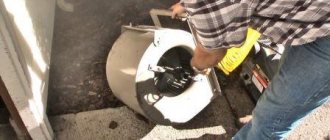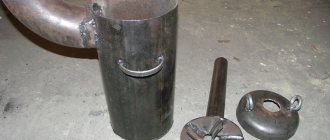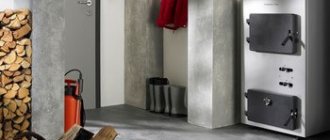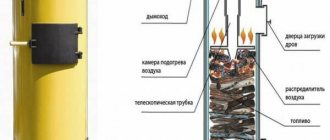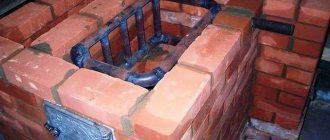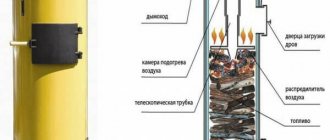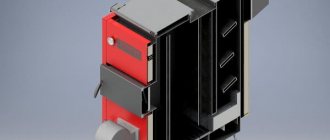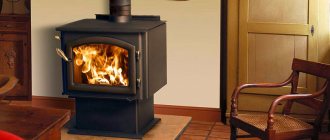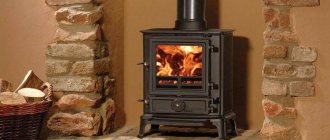During the construction phase, it is possible to think through the heating in the best possible way, but even if the goal is to reorganize the existing system, high efficiency can be achieved.
It is when the owner decides to do everything thoroughly that the conversation usually turns to choosing a long-burning stove with a water circuit.
This is an option not for a country house, but for a large, solid house or cottage where people will permanently live.
At the same time, such equipment allows the owner not to turn into a round-the-clock fireman. What kind of devices are these, what types are there, and is it worth combining a long-lasting boiler with radiators? Let's consider these questions, as well as the range of models.
Operating principle of a water circuit furnace
The disadvantage of conventional solid fuel stoves is that the combustion process is very intense here.
As a result, the full potential of the fuel is not used, and a person has to very often replenish the supply of coal or firewood.
Long-burning stoves mean all designs designed to slow down the combustion process, “extract” all their capabilities from firewood and automate the supply of fuel or increase the gap between manual fillings.
A water circuit is necessary if we are talking about a large house. Transferring energy to water through a heat exchanger allows heat to be distributed to all rooms and floors of the building. Otherwise, it would be possible to heat only those rooms with which the body of the stove is in contact (convection and radiant heat).
Any stove is designed to heat a small room, and if you need to heat a large house, then stove heating with a water circuit is used. System elements, installation rules, pros and cons of this type of room heating - read in detail about all this.
The main types of heating for a private home are presented in this review.
And in this topic there are useful recommendations for choosing heated floors. Which is better - water or electric option?
Existing types and their features
The type of fuel (available to you) is the first, most important, and often decisive factor that influences the choice of boiler model. What will it be: firewood, coal, pellets, or liquid fuel?
The designs are developed for certain fuel parameters, which are prescribed in the instructions.
The closer the owner adheres to these recommendations, the more pleased he will be with the result.
Boilers can be divided according to the operating principle:
- Gas generating or pyrolysis.
- Long burning, smoldering.
The design of gas generating units makes it possible to burn gases that usually fly out into the chimney. The difference from the second option is that this happens in a separate chamber (often it looks like a labyrinth of metal passages). Efficiency increases, and in addition, in such furnaces the combustion process is a little slower, so you have to load fuel a little less often.
If your goal is to look into the stoker as little as possible, you should pay attention to full-fledged long-burning heating stoves with a smoldering water circuit. The point here is that the vertical cavity of the firebox is clogged with fuel and combustion proceeds from top to bottom (practically smoldering). There are models with a lower flame, and slow combustion is ensured by a limited air supply. The process of pyrolysis also occurs, but most often right here, in a slowly smoldering flame.
A number of models are equipped with automatic fuel supply. This type of device is the easiest to look after.
What are the differences?
Before buying and installing a stove in your home with a water circuit, we recommend that you familiarize yourself with the following design features of long-burning solid fuel systems:
- These fireplaces are distinguished by the presence and achievement of the maximum level of efficiency during use. To do this, the manufacturer uses the principle of pyrolysis or generation of gas masses. The temperature in the combustion chamber can reach about 180-220 degrees, while oxygen is supplied in a small, strictly limited amount. Thus, the logs begin to smolder very slowly, generating a large amount of heat. In this case, carbon dioxide is formed, which is also promptly processed in a compartment of the structure designated for these purposes;
- Heating stoves for long-burning homes have a large combustion chamber that can accommodate a large number of logs, which do not need to be chopped several times. The increased size of the hearth allows the heating device to operate from one load to ten hours continuously;
- Teplodar fireboxes and other fireplaces with a water circuit are additionally connected to the general heating system of the house, thereby being able to accumulate, accumulate heat, and distribute it evenly throughout all rooms and even across several floors of the cottage;
- Many models of stoves with a long-burning function, a water circuit, are equipped with a door made of tempered transparent glass, through which it is convenient to observe the combustion process in the flame.
The main components of a wood-burning hearth: the firebox is shown in section
Cast iron combustion chamber with round firebox without glass
It is interesting to know: this system functions and produces heating not only due to a water jacket, a long-term combustion system, but also convection (the walls of the device warm up and release heat from the given room, as well as those adjacent to it).
Popular stove models
- Stropuva. The Lithuanian brand Stropuva has a wealth of experience that has ensured popularity among customers. Vertical long-burning boilers of various modifications are produced, including pellet boilers and universal ones (for firewood, pellets, coal) of various capacities. Electricity-dependent or not, but all single-circuit. The popularity of the Stropuva Mini S8 model (8 kW; firewood, briquettes) is most likely due to its low cost - 65 - 68 thousand rubles.
- Bioterm Krzaczek. Polish devices Bioterm Krzaczek are also successful, but their prices are slightly higher. For example, SK-SADOWY 18 (one of the most inexpensive) - 98 - 100 thousand rubles.
- Teplodar. A long-burning stove with a water circuit, Teplodar Kupper PRO 22, can operate on wood, coal, and briquettes. You can also install a pellet or gas burner on it (included). Built-in heating elements that maintain the temperature when the fuel burns out. The price of a domestic miracle does not reach 30 thousand rubles.
- Trayan T-10 is a popular pyrolyzer with two circuits (heats water for household needs). Works on wood, briquettes and peat. Efficiency 85%.
- “Bourgeois-K” Standard-10 is another 10 kW pyrolysis unit. It is also double-circuit, but there is only 2 liters of water in the DHW heat exchanger. Works on firewood, wood and peat briquettes, as well as coal with a calorie content of no more than 6 thousand kcal.
Mention of fuel requirements is not just words. If you neglect the instructions of the developers, the furnaces will not work for the calculated amount of time, or will begin to go out, become clogged with soot, etc. In any case, the result will not be satisfactory.
Design Features
Pyrolysis boilers are one of the types of solid fuel boilers, which have recently been in increased demand due to constantly rising prices for gas and electricity; they are also called gas generator boilers.
The main fuel for a pyrolysis solid fuel boiler is:
- wood;
- briquettes;
- wood chips;
- wood waste.
Very rarely, coal or coke is used as fuel. Pyrolysis boilers are easy to use, reliable and have a long service life. Before buying a pyrolysis boiler, you need to study the possibility of meeting strict requirements for the quality of the fuel used.
In the vast majority of cases, it is allowed to use wood with a moisture content of no more than 20%. When using wood with a large amount of moisture, efficiency decreases sharply.
The pyrolysis boiler operates on the principle of dry distillation of fuel.
With a lack of oxygen, under the influence of high temperature, dry wood decomposes into a solid residue and a volatile part (pyrolysis gas, which is subsequently mixed with hot air).
This air-gas mixture, which was formed during the pyrolysis process, is the fuel of the pyrolysis boiler. The pyrolysis combustion process is exothermic (accompanied by the release of heat).
It occurs at temperatures from 200 to 800 °C and provides heating of the air entering the combustion chamber. In this case, the fuel in the unit chamber is heated and dried, thereby minimizing the release of soot and ash.
A pyrolysis or gas generator boiler is characterized by a higher efficiency compared to traditional solid fuel equipment.
When burning high-quality fuel, the efficiency of a pyrolysis boiler is at the level of pellet boilers and long-burning boilers and reaches 90%.
Pyrolysis solid fuel boilers are used both in private houses and apartments, and for heating industrial premises.
Pyrolysis boilers are a very cost-effective type of heating equipment. The fairly high price of a pyrolysis boiler is covered by low fuel consumption.
In a conventional long-burning solid fuel unit, the coolant is heated by the heat released during fuel combustion, but pyrolysis boilers operate on a different principle.
When burning organic fuel (wood, pellets, wood briquettes and even coal) at a temperature of 400-800°C, gas is released, burning which can produce much more heat than when burning fuel.
The process of gas formation from solid fuel and subsequent combustion of the resulting gas is called pyrolysis, and units using this operating principle are called pyrolysis, or gas generator boilers.
There are two chambers in the pyrolysis boiler, and combustion takes place in both:
- Combustion chamber – wood or other fuel is burned (charred).
- Afterburner – the gas emitted by the fuel is burned.
Fuel is located and ignited in the combustion chamber. Primary air is supplied to the combustion zone. When the fuel warms up to a certain temperature, gas evolution begins.
Using a smoke exhauster, gas, together with secondary air, is sucked into the afterburner chamber (it is located below the fuel level) and burns there, releasing heat.
Combustion products enter the smoke duct (flue) and enter the chimney, passing through the water jacket of the unit and heating the coolant.
As a result, firewood turns into charcoal, burning almost completely, and the smoke is cleared of unpleasant odors and carbon monoxide.
Gas generator furnaces
In RuNet, “gas generator” stoves usually mean small heating devices, such as Buleryan, Breneran or Professor Butakov.
There are many options for such devices; they are united by the presence of convection pipes, small sizes and the fact that they are more suitable for small houses with 1-2 rooms than for being built into a full-fledged system with a water jacket.
Strictly speaking, it’s a stretch to call them gas generators. The presence of a small second combustion chamber, where partial afterburning occurs, does not make them so. There is no catalyst, pressurized air supply, or high temperatures characteristic of pyrolysis. If you compare the technical characteristics of the models above and small convection ovens, the difference becomes obvious.
Efficiency and problems
The effectiveness of long-burning systems is a controversial issue. Much depends not only on the selected power of the home equipment itself, but also on the correct installation, placement, and connection to the heating system with your own hands.
Mostly stoves with a water jacket are suitable for heating an area not exceeding 170-210 square meters.
The presence of tempered transparent glass allows you to control and observe the combustion process of the flame in the hearth
A large selection of products allows you to choose a fireplace of a wide variety of sizes, shapes, and styles
Among the most common problems are:
- Low level of heat transfer. This may be due to the fact that fuel with a high humidity percentage of 20-30 is used to light the stove. In order for the long-term combustion system to move to the gas generation stage, it is necessary to perform preliminary heating in standard mode for 10-15 minutes and only after that the power is increased so that the output temperature is about 210 degrees. Next, simply close the damper, almost completely leaving a small gap;
- Some lesions become deformed over time. This is due to the fact that initially you or a specialist made an incorrect connection or the requirements and standards specified in the documentation attached to the fireplace were violated.
Homemade gas generators
The most popular homemade long-burning stoves with a water circuit, made on the basis of Stropuva, are Bubafonya. Drawings can be easily obtained on the RuNet. Here there is vertical combustion, and the stages of pyrolysis are mixed and occur everywhere and at once.
The air supply is carried out through a central small tube located in a pancake - a pressure that prevents gases from escaping upward.
The lower part of the pancake must have curved blades - they are needed so that the released gases linger a little, swirl on the surface and have time to burn out before flying out into the chimney. The chimney is taken out to the side and combined with a condensate collector.
Homemade Bubafonya
Cons you need to know about:
- The stove is not compatible with coal and pellets.
- The efficiency of Bubafoni will not reach 80%.
- You can't cook on it.
- You need to wait for the fuel to completely burn out in order to clean the boiler and only then fire it up again. Judging by the reviews, this technology does not perform well in cold weather. The heat from the remaining fuel is no longer enough - you have to wait and feel cold.
- Cleaning and adding fuel is inconvenient and difficult.
If you connect Bubafonya to a water circuit, then the heat exchanger must be installed at some distance from the walls of the boiler. It is also necessary to construct a protective screen (it will also increase the efficiency of the furnace), since the walls become hot and red.
Pellet stoves
Pellets are conquering the energy market today. Somewhere they are available due to the fact that they are produced from waste. In some places it is becoming more and more difficult to get classic fuel (wood and coal), while others like the fact that pellets are suitable for supply automation.
An additional bunker is installed to the boiler, into which a large volume of pellets is loaded at once and, as they are consumed, the fuel is supplied by an auger into the chamber. The main element of any such boiler is a special pellet burner, which is almost impossible to replicate at home, and the price of which makes up a large part of the total cost of the boiler.
Pellet boiler Valdai 15M2
Examples of models with a water circuit:
- Valdai 15M2 – 15 kW. In emergency cases, it will be able to “digest” both coal and firewood. Efficiency with wood is 76%, with pellets up to 90%. 120 – 125 thousand rubles.
- Cooper OVK 10 (from Teplodar, Russia). This is not strictly a pellet boiler. It can be a compact solid fuel stove with a hob. But by adding a tank and burner it turns into a pellet one. Another special feature is that the tank is built on top and takes up less space in the boiler room than other similar devices. Open chamber, single-circuit, efficiency 75%, price: 75 - 90 thousand rubles.
- Peresvet 10MA (from Obshchemmash, Russia). Backup fuel – briquettes and firewood. The bunker is installed next to the boiler, single-circuit. Price – about 150 thousand rubles.
You can convert many simple solid fuel boilers to pellets by purchasing a burner and a bunker (or even building the latter yourself - it works out a little cheaper).
With or without water circuit?
The need to install water heating is dictated by the conditions in a particular case.
You can do without radiators in a small 1-2 room house if you ensure good air circulation or place the heating device in both rooms. But even then it is difficult to protect the walls from freezing in the corners.
It is also worth refraining from installing a water circuit if the home is periodically left without an owner (but there are alternative solutions for this too - modern technology allows you to set economical modes that maintain temperature at around +5 °C without human intervention).
The routing of pipes with coolant will allow you to heat all rooms in the house and distribute the heat more evenly. Most long-burning boilers are equipped with good built-in heat exchangers that are easy to connect to the heating system of the house.
Advantages and disadvantages
Advantages of use:
- when burning firewood, it is impossible to obtain such a high temperature as during the combustion of pyrolysis gas (especially if the firewood contains a lot of moisture);
- With the help of a control controller, we can automate the operation of a pyrolysis boiler without much difficulty, since the combustion process of pyrolysis gas is easy to control and regulate;
- burning wood or coal requires much more secondary air than burning wood gas. Therefore, with the same volume of secondary air, the combustion efficiency of wood gas, the duration and temperature of combustion will be greater;
- the emission of harmful substances from pyrolysis boilers into the atmosphere is reduced to a minimum, therefore a pyrolysis boiler is an almost environmentally friendly source of heat;
- solid fuel pyrolysis combustion boilers need to be cleaned from ash extremely rarely;
- pyrolysis boilers can operate for a very long time (up to 15 hours) on one load of firewood, while conventional solid fuel boilers need to be reloaded every 3-4 hours.
If we talk about the disadvantages of this type of unit, then, in addition to the price, which is the price for increased efficiency, and a more complex design, because pyrolysis boilers are 30-35% heavier than conventional ones, since more metal is required for their manufacture, other “disadvantages” insignificant.
For maximum operating efficiency, the moisture content of firewood should be no more than 20%. If the wood is wet, when it burns, steam is generated, which reduces gas emissions and leads to the deposition of tar and soot. As a result, the efficiency of the boiler decreases, and there is a need to clean it.
Most pyrolysis units are electronically controlled.
Consequently, it becomes necessary to use electricity to operate the controller, which controls the fan and smoke exhauster.
Pyrolysis boilers with natural draft exist, but they require a very high and powerful chimney, so such models are unpopular.
The need to fill the firebox by 50-100% - only in this case will the high efficiency of the boiler be maintained.
Long-burning pyrolysis solid fuel boilers, although twice as expensive as a conventional solid fuel boiler, are distinguished by the possibility of economical use of fuel with maximum efficiency, which is significantly higher than from the combustion of coal and wood in conventional units.
